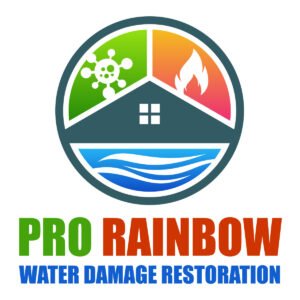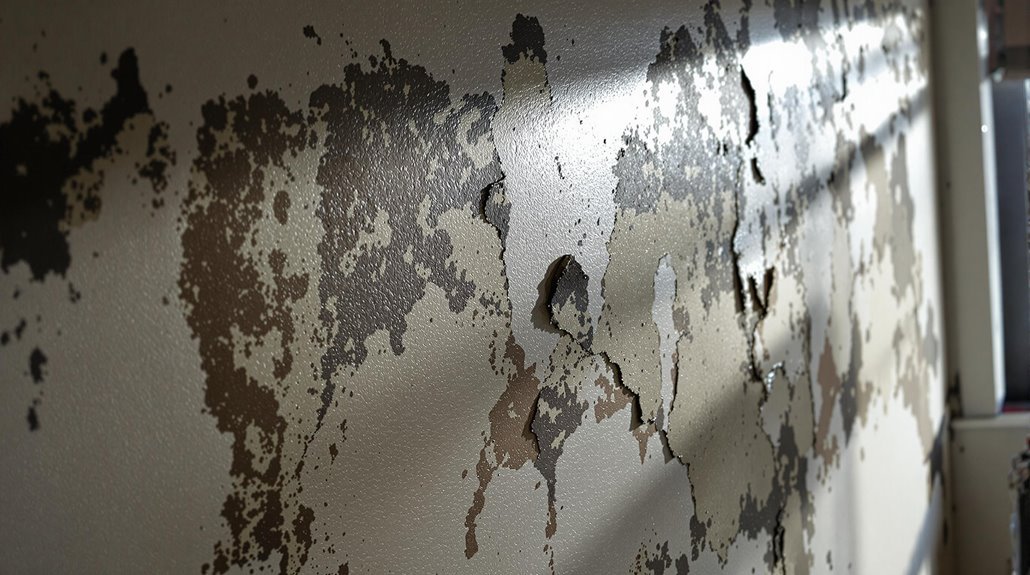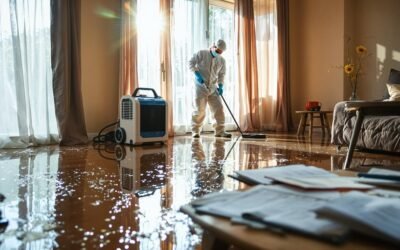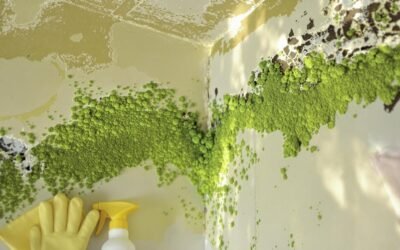Mold doesn't always grow on wet drywall, but the likelihood increases considerably within 24 to 48 hours of moisture exposure. Several factors contribute to this, including humidity levels above 60% and the presence of organic materials. If you want to prevent mold, guarantee proper ventilation and promptly address leaks or damp areas. Using mold-resistant materials and maintaining humidity between 30-50% is critical. Regular inspections for hidden moisture sources, like under sinks or around windows, can likewise help. Understanding these management strategies will empower you to protect your home effectively. Uncover more strategies to keep moisture at bay.
Key Takeaways
- Mold requires moisture, so wet drywall is at risk, but not all wet drywall will immediately develop mold.
- Germination of mold spores typically occurs within 24 to 48 hours under suitable conditions, emphasizing the need for prompt action.
- Maintaining indoor humidity below 60% is essential to prevent mold growth on wet materials like drywall.
- Using mold-resistant materials during installation can help mitigate the risk of mold growth on drywall exposed to moisture.
- Regular inspections and immediate repairs of leaks are crucial for preventing mold on drywall and other building materials.
Understanding Mold Growth
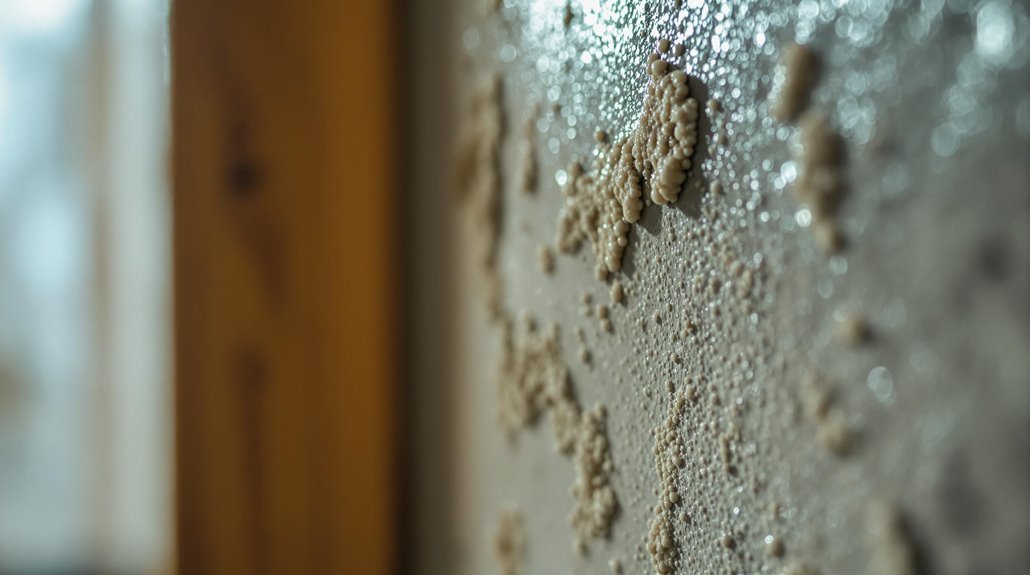
Mold growth occurs when specific environmental conditions are met, primarily involving moisture, warmth, and organic material. Understanding the mold lifecycle is essential for prevention. It begins with mold spores, which are ubiquitous in the environment. When these spores land on a suitable surface and the conditions are right, they absorb moisture and begin to germinate. This process typically takes 24 to 48 hours. As the mold colonizes the area, it produces new spores, which can spread rapidly. You might notice visible signs of mold within days if conditions persist. Recognizing this lifecycle allows you to identify and mitigate potential mold growth before it becomes a significant issue. Managing moisture levels and maintaining cleanliness are fundamental steps in mold prevention. Additionally, fast drying techniques can significantly reduce the risk of mold growth post-water damage.
Conditions Favoring Mold
Mold thrives in environments where moisture levels are high, making humidity control essential. Temperature likewise plays a significant role, as certain ranges can accelerate mold growth. By understanding these conditions, you can better manage your space and prevent infestations. Implementing mold prevention strategies can significantly reduce the risk of mold growth in your home.
Moisture Levels Impact Growth
When humidity levels rise above 60%, conditions become increasingly favorable for mold growth. To effectively manage moisture levels, you need to prioritize moisture measurement and humidity control. Here are some critical factors to take into account:
- Relative Humidity: Keep it below 60% to deter mold.
- Ventilation: Guarantee proper airflow in enclosed spaces.
- Water Leaks: Address any plumbing issues immediately.
- Condensation: Monitor areas prone to moisture accumulation.
- Damp Materials: Remove wet drywall or insulation promptly.
Temperature and Humidity Effects
Understanding how temperature interacts with humidity is vital for preventing mold growth. Mold thrives in warm, humid environments, typically between 77°F and 86°F (25°C to 30°C). When indoor temperatures rise, so can humidity levels, especially if you lack proper temperature control. High humidity, above 60%, creates a favorable environment for mold spores to germinate on wet drywall. To combat this, promote effective humidity regulation through dehumidifiers or ventilation. Keeping your indoor environment cooler—ideally below 70°F (21°C)—can greatly reduce mold risk. Moreover, maintaining low humidity levels will help prevent mold, even in damp conditions. By managing both temperature and humidity, you can create an inhospitable environment for mold growth.
Types of Mold on Drywall

Various types of mold can thrive on drywall, each presenting unique challenges and health risks. Understanding these molds is essential for effective prevention and remediation. Here are some common types you should be aware of:
- Black Mold: Often linked to severe health issues, it's toxic and requires immediate attention.
- White Mold: Typically less harmful, but it can still cause allergic reactions.
- Green Mold: Commonly found in damp areas; it can lead to structural damage over time.
- Toxic Mold: This includes various species that produce harmful mycotoxins.
- Allergenic Mold: Causes allergic reactions and respiratory issues, often found in homes.
Recognizing these molds helps you take proactive measures to safeguard your living space.
Signs of Mold Infestation
Mold infestations can often go unnoticed until they escalate into more significant problems. To effectively identify mold growth, you should employ various mold detection techniques. Start by looking for visual mold indicators, such as dark spots or fuzzy patches on surfaces. These can appear in various colors, including black, green, or white. Furthermore, pay attention to any musty odors in enclosed spaces, as these often signal hidden mold colonies. Inspect areas prone to moisture, like bathrooms and basements, for any discoloration or peeling paint. If you notice any of these signs, act quickly to address the issue before it worsens. Early detection is vital in preventing extensive damage and health risks associated with mold exposure.
Importance of Moisture Control
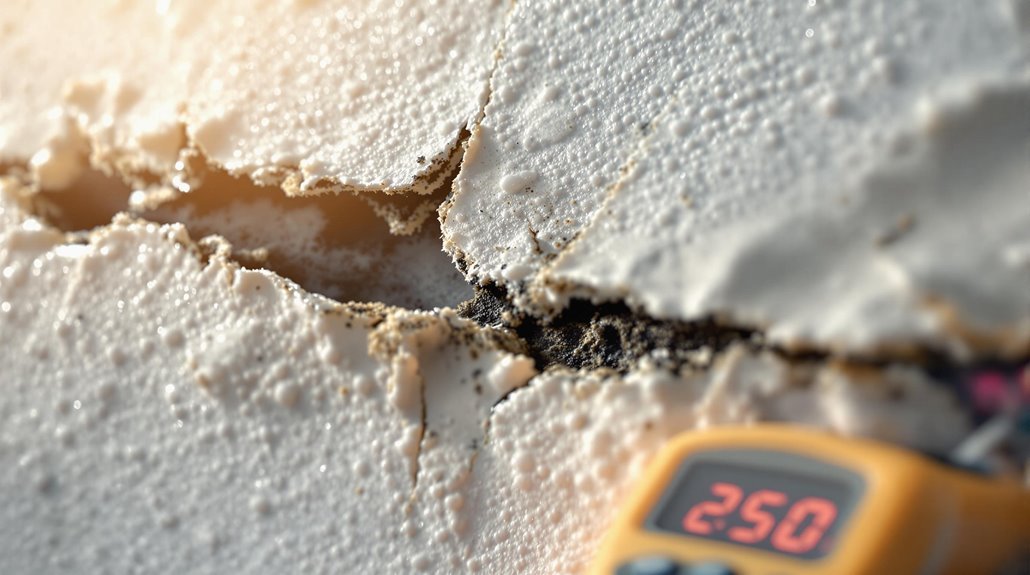
Controlling moisture is essential in preventing mold growth in your home. High humidity levels, inadequate ventilation, and delayed water damage repairs can create ideal conditions for mold to thrive. By understanding and managing these factors, you can greatly reduce the risk of mold infestations.
Role of Humidity
While you may not realize it, humidity plays a vital role in mold prevention and overall moisture control within your home. Maintaining proper humidity levels is important for effective moisture management. High humidity can create an environment ripe for mold growth. Here are key aspects of humidity control:
- Ideal Range: Keep indoor humidity between 30-50%.
- Dehumidifiers: Use them to reduce excess moisture, especially in basements.
- Condensation: Watch for condensation on windows and pipes, as it indicates high humidity.
- Humidity Monitors: Invest in a hygrometer to track levels accurately.
- Seasonal Adjustments: Be proactive during humid summer months to prevent spikes in moisture.
Effective Ventilation Strategies
Effective ventilation strategies are crucial for maintaining moisture control in your home, as they help to circulate air and reduce humidity levels. Proper airflow management prevents stagnant air, which can lead to mold growth. Implementing effective ventilation systems guarantees that moisture is expelled and fresh air is brought in, creating a healthier environment.
| Ventilation Type | Benefits | Ideal Locations |
|---|---|---|
| Natural Ventilation | Cost-effective, energy-efficient | Windows, vents |
| Mechanical Ventilation | Controlled airflow, consistent | Bathrooms, kitchens |
| Exhaust Ventilation | Removes excess moisture quickly | Laundry rooms, attics |
Timely Water Damage Repair
Timely water damage repair is vital for preventing mold growth and preserving the integrity of your home. When you address water damage promptly, you minimize moisture levels and reduce the risk of mold infestations. Here are some fundamental repair techniques to take into account:
- Identify the source of the water damage.
- Remove wet drywall and insulation.
- Use dehumidifiers to lower humidity.
- Apply mold-resistant treatments to affected areas.
- Guarantee proper ventilation during the drying process.
Drying Wet Drywall Effectively
When you encounter wet drywall, addressing the issue promptly is crucial to prevent mold growth and structural damage. Start by identifying the source of moisture and stopping it. Use effective drying techniques such as fans and dehumidifiers to promote moisture removal. Position fans to create a crosswind that accelerates evaporation. A temperature increase can likewise improve drying speed, so consider using a heater if safe. Remove any water-soaked insulation or materials, as they can retain moisture and hinder the drying process. Regularly check the drywall's moisture level with a moisture meter until it reaches an acceptable range. By implementing these methods, you can effectively dry wet drywall and minimize the risk of mold development.
Ventilation and Airflow Solutions
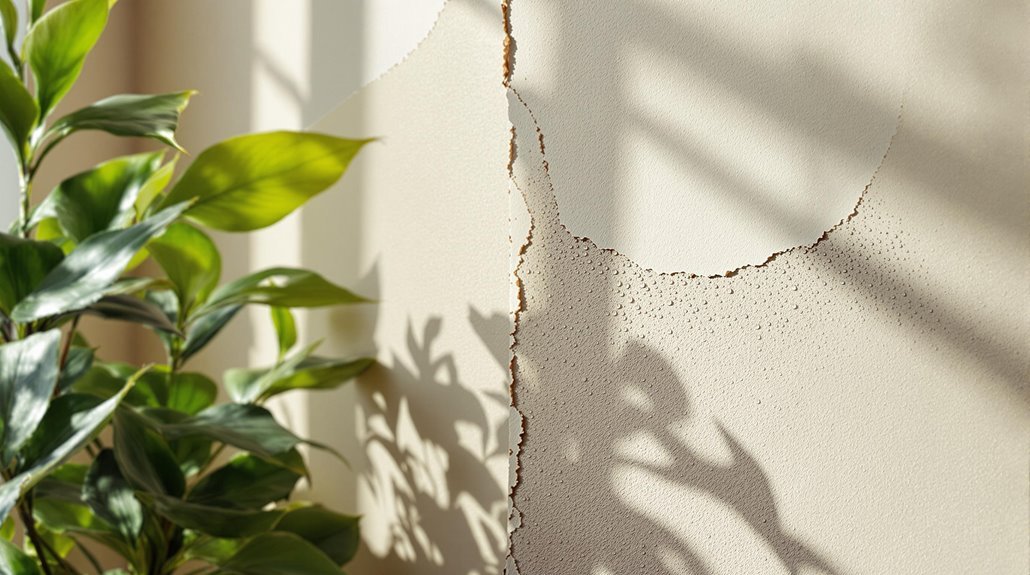
After addressing the immediate concerns of drying wet drywall, it's crucial to maintain proper ventilation and airflow in the affected area. Effective airflow management and humidity control can greatly reduce the risk of mold growth. Here are some strategies you can implement:
- Use dehumidifiers to lower moisture levels.
- Open windows and doors to promote cross-ventilation.
- Install exhaust fans in high-humidity areas, like bathrooms and kitchens.
- Utilize air movers or fans to circulate air around the drywall.
- Regularly check for signs of moisture or dampness.
Using Mold-Resistant Materials
When you're selecting materials for construction or renovation, choosing mold-resistant options can markedly improve your home's durability. Familiarizing yourself with the various types of mold-resistant materials, along with their installation best practices, is essential for effective mold prevention. Furthermore, understanding long-term maintenance tips will help you sustain these materials' protective qualities over time.
Types of Mold-Resistant Materials
As you consider strategies for mold prevention, choosing the right materials is crucial to creating a resilient environment. Utilizing mold-resistant materials can greatly reduce the risk of mold growth. Here are some options to investigate:
- Mold-resistant drywall: Specifically designed to resist moisture and mold, ideal for high-humidity areas.
- Moisture barriers: These membranes help prevent water infiltration, protecting walls and ceilings.
- Mold-resistant paint: Formulated with antimicrobial agents to inhibit mold growth on surfaces.
- Fiberglass insulation: Non-organic and resistant to moisture, making it less likely to support mold.
- Composite building materials: Some engineered woods come treated to resist mold and moisture.
Installation Best Practices
Selecting mold-resistant materials is just the starting point; proper installation is key to maximizing their effectiveness. Employing correct installation techniques guarantees that your drywall materials perform as intended. First, make certain that all surfaces are clean and dry before installation to prevent moisture accumulation. Use mold-resistant tape and joint compounds to seal seams effectively. Furthermore, maintain proper spacing and ventilation during installation to allow for airflow, reducing the risk of mold growth. Be mindful of humidity levels in your environment, as excessive moisture can compromise even the best materials. Finally, inspect for any gaps or imperfections post-installation, as these can become potential mold growth spots. By following these guidelines, you'll improve the longevity and performance of your mold-resistant drywall.
Long-Term Maintenance Tips
To secure the long-term effectiveness of mold-resistant materials, regular maintenance is vital. Implementing consistent preventative measures guarantees you minimize mold growth risks. Here are some key tips:
- Schedule routine mold inspections to identify any potential issues early.
- Keep humidity levels below 60% by using dehumidifiers in damp areas.
- Regularly clean and maintain HVAC systems to prevent moisture buildup.
- Inspect plumbing and roofs for leaks and repair any issues immediately.
- Use appropriate cleaning agents that inhibit mold growth on surfaces.
Regular Maintenance Practices

Regular maintenance practices play a vital role in mold prevention, guaranteeing that your environment remains dry and healthy. Engaging in regular inspections of areas prone to moisture, such as basements and bathrooms, helps you identify potential issues before they escalate. Look for signs of water damage, including discoloration and peeling paint. Furthermore, routine cleaning is important; it removes dust and organic materials that mold thrives on. Pay special attention to areas around windows, pipes, and appliances. Verify your gutters are clear and downspouts direct water away from your foundation. By committing to these practices, you greatly reduce the risk of mold growth, creating a safer living space for you and your family.
Identifying Hidden Moisture Sources
How can you effectively identify hidden moisture sources in your home? Start by using moisture detection tools to pinpoint areas that may harbor hidden leaks. Here are some common areas to check:
- Under sinks and behind cabinets
- Around windows and door frames
- In attic spaces and crawl spaces
- Near appliances like dishwashers and washing machines
- Behind drywall or paneling
Perform regular inspections in these spots, looking for discoloration, warping, or mold growth. If you suspect hidden leaks, consider using a thermal imaging camera for more accurate detection. By being proactive in identifying these moisture sources, you can mitigate the risk of mold growth and maintain a healthier living environment.
Professional Mold Assessment
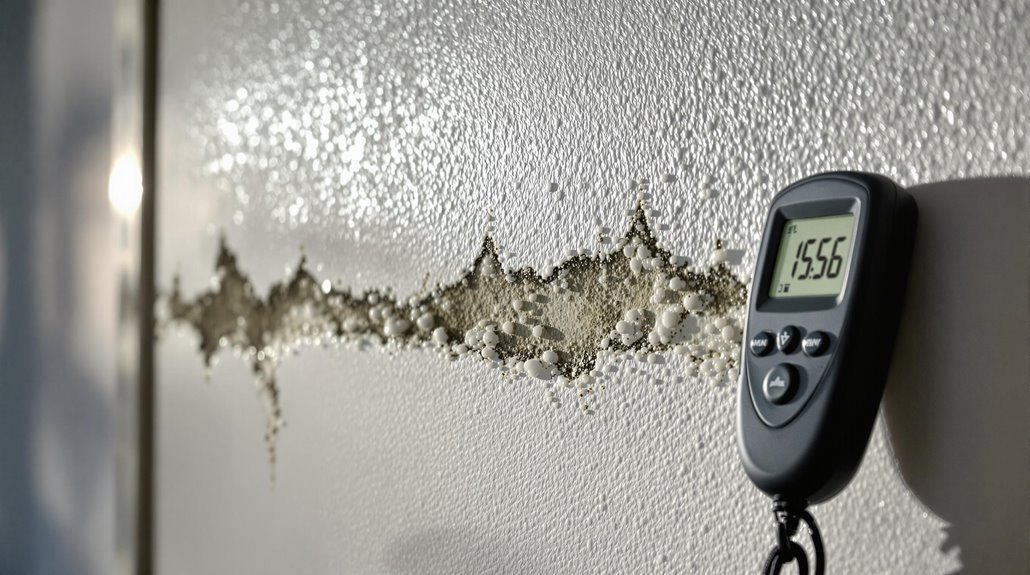
While many homeowners can take initial steps to manage mold, a professional mold assessment provides a thorough evaluation that identifies the extent of mold growth and underlying moisture issues. Trained specialists use advanced mold testing and assessment techniques to detect mold in areas you might overlook. They often employ tools like moisture meters and thermal imaging cameras to uncover hidden moisture sources that contribute to mold proliferation. Furthermore, they can take air and surface samples to determine the specific types of mold present. By obtaining a detailed report, you'll gain insights into necessary remediation steps and prevention measures. Ultimately, this professional assessment equips you with the knowledge to address mold issues effectively and safeguard your home.
Long-Term Mold Prevention Strategies
To effectively prevent mold growth over the long term, it's essential to control moisture levels and maintain proper ventilation throughout your home. Implementing the following preventive measures can greatly reduce the risk of mold:
- Regularly inspect and repair leaks in roofs, pipes, and walls.
- Use dehumidifiers in damp areas like basements and bathrooms.
- Guarantee adequate airflow by using exhaust fans and opening windows.
- Keep gutters clean and direct water away from your foundation.
- Educate yourself and your family about mold growth and prevention.
Conclusion
To summarize, while not every instance of wet drywall leads to mold growth, the risk remains significant. A staggering 50% of homes in the U.S. experience mold at some point because of moisture issues. To safeguard your living space, prioritize moisture control and regular maintenance. By identifying hidden moisture sources and implementing long-term prevention strategies, you can effectively minimize the likelihood of mold infestations and protect your home's integrity. Stay proactive for a healthier environment.
